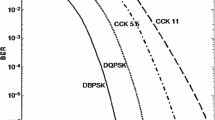Abstract
In this paper, a rate adaptive protocol AMARF (Adaptive Multirate Auto Rate Fallback) for multirate IEEE 802.11 networks is proposed. In AMARF, each data rate is assigned a unique success threshold, which is a criterion to judge when to switch a rate to the next higher one, and the success thresholds can be adjusted dynamically in an adaptive manner according to the running conditions, such as packet length and channel parameters. Moreover, the proposed protocol can be implemented by software without any change to the current IEEE 802.11 standards. Simulation result shows that AMARF yields significantly higher throughput than other existing schemes including ARF and its variants, in various running conditions.
Similar content being viewed by others
References
IEEE, Part 11: Wireless LAN Medium Access Control (MAC) and Physical Layer (PHY) Specifications. IEEE Std 802.11-1999, Aug. 1999.
IEEE 802.11b, Part 11: Wireless LAN Medium Access Control (MAC) and Physical Layer (PHY) Specifications: High-speed Physical Layer Extension in the 2.4GHz Band. Supplement to IEEE 802.11 Standard, Sept. 1999.
IEEE 802.11a, Part 11: Wireless LAN Medium Access Control (MAC) and Physical Layer (PHY) Specifications: High-speed Physical Layer in the 5GHz Band. Supplement to IEEE 802.11 Standard, Sept. 1999.
G. Holland, N. Vaidya, P. Bahl. A rate-adaptive MAC protocol for multi-hop wireless networks. In Proc. ACM MOBICOM’01, Rome, Italy, 2001, 236–251.
B. Sadeghi, V. Kanodia, A. Sabharwal, E. Knightly. Opportunistic media access for multirate ad hoc networks. In Proc. ACM MOBICOM’02, Atlanta, USA, Sept. 2002, 24–35.
A. Kamerman, L. Monteban. \WaveLAN-II: A high-performance wireless lan for the unlicensed band. Bell Labs Technical Journal, Summer 1997, 118–133.
P. Chevillat, J. Jelitto, A. N. Barreto. A dynamic link adaptation algorithm for IEEE 802.11a wireless LANs. In Proc. IEEE ICC’03. Anchorage, AK, May 11–15, 2003, vol.2, 1141–1145.
D. Qiao, S. Choi. Fast-responsive link adaptation for IEEE 802.11 WLANs. In Proc. IEEE ICC’05, Seoul, Korea, May 16–20, 2005, vol.5, 3583–3588.
W. C. Jakes. Microwave Mobile Communications. New York, IEEE Press, Wiley Interscience, 1994, 65–73.
Glomosim simulator. http://pcl.cs.ucla.edu/projects/glomosim.
Q. Zhang, Saleem A. Kassam. Finite-state Markov model for Rayleigh fading channels. IEEE Trans. on Communications, 47(1999)11, 1688–1692.
Author information
Authors and Affiliations
Corresponding author
Additional information
Communication author: Xi Yong, born in 1977, male, Ph.D., instructor. School of Electronic Science and Engineering, National University of Defense Technology, Changsha 410073, China.
About this article
Cite this article
Xi, Y., Huang, Q., Wei, J. et al. Rate adaptive protocol for multirate IEEE 802.11 networks. J. of Electron.(China) 24, 289–295 (2007). https://doi.org/10.1007/s11767-006-0008-6
Received:
Revised:
Published:
Issue Date:
DOI: https://doi.org/10.1007/s11767-006-0008-6




